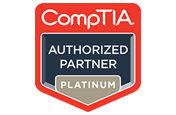We're open through the holidays to support your upskilling goals — Which training do you want to book?
We're open through the holidays to support your upskilling goals — Which training do you want to book?
Unable to find what you're searching for?
We're here to help you find itCompTIA Network+ (N10-008) Course Overview
The CompTIA Network+ (N10-008) course is a comprehensive training program designed to equip learners with the essential knowledge and skills needed for a career in Infrastructure. Covering a wide range of topics, this course delves into Networking concepts, Infrastructure, Network operations, network security, and Troubleshooting. By engaging with the course material, students will gain a deep understanding of the seven layers of the Open Systems Interconnection (OSI) model, Network topologies, Cable types, IP addressing, and key Protocols and services used in networking.
With Network Plus training, participants will learn to configure, manage, and troubleshoot networks, ensuring they can handle various real-world networking scenarios effectively. The N10-008 curriculum prepares learners for the CompTIA Network+ certification exam, a valuable credential for networking professionals. The knowledge gained from this course will not only help learners to achieve certification but also provide a solid foundation for a successful career in network administration and support.
Successfully delivered 51 sessions for over 111 professionals
Purchase This Course
USD
View Fees Breakdown
| Course Fee | 2,950 |
|
Total Fees |
2,950 (USD) |
USD
View Fees Breakdown
| Course Fee | 2,250 |
|
Total Fees |
2,250 (USD) |
USD
View Fees Breakdown
| Flexi Video | 16,449 |
| Official E-coursebook | |
| Exam Voucher (optional) | |
| Hands-On-Labs2 | 4,159 |
| + GST 18% | 4,259 |
|
Total Fees (without exam & Labs) |
22,359 (INR) |
|
Total Fees (with Labs) |
28,359 (INR) |
Select Time
Select Date
| Day | Time |
|---|---|
|
to
|
to |
♱ Excluding VAT/GST
You can request classroom training in any city on any date by Requesting More Information
Inclusions in Koenig's Learning Stack may vary as per policies of OEMs
Scroll to view more course dates
You can request classroom training in any city on any date by Requesting More Information
♱ Excluding VAT/GST
*Inclusions in Koenig's Learning Stack may vary as per policies of OEMs
Suggestion submitted successfully.
Koenig Learning Stack
Inclusions in Koenig's Learning Stack may vary as per policies of OEMs



